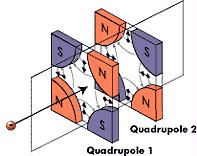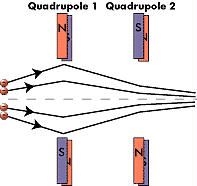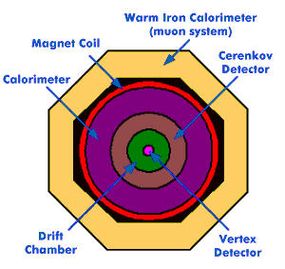Magnets, Targets and Detectors


Magnets
Magnets, either conventional electromagnets or superconducting magnets, are placed along the accelerator tube at regular intervals. These magnets keep the particle beam confined and focused.
Imagine that the particle beam is like shot pellets fired from a shotgun shell. Typically, the pellets (electrons) tend to spread out. If the pellets are spread out, then they do not make many collisions within the narrow area of the target. However, if the pellets are confined by an external force (magnetism) to a narrow path, then they will make many collisions in the narrow target area. The more collisions, the more events that can be observed in any one experiment.
Advertisement
The magnets generate a field within their core. There is no magnetic force in the center where the electrons travel. If the electrons stray from the center, they will feel a magnetic push back into the middle. By arranging the magnets in a series of alternating poles, the electrons can remain confined down the length of the tube.
Targets
Targets vary with the type of experiment. Some targets can be thin sheets of metal foil. In some experiments, beams of different particles (electrons, positrons) collide with each other inside the detectors.
Detectors
The detectors are one of the most important pieces of equipment in the accelerator. They see the particles and the radiation after the collision. Detectors come in many types, from bubble and cloud chambers to solid-state electronic detectors. A collider laboratory may have several types of detectors located at various parts of the accelerator. For example, a bubble chamber contains a liquid gas, such as liquid hydrogen. As the particles released from the collision pass through the chamber, they vaporize some of the liquid, leaving a bubble trail as shown below.
A cloud chamber detector has a saturated vapor inside the chamber. As an energetic particle passes through the vapor, the vapor is ionized, producing a trail much like the one made by a jet moving through a cloud (see "Why do those long white clouds form behind jets flying high overhead?" for details).
One detector at SLAC is the SLAC Large Detector (SLD). The SLD is a large, barrel-shaped, solid-state detector that stands more than six stories tall and weighs more than 4,000 tons!
SLD is a multi-layered detector. Each layer sees a different event:

- Vertex detector - detects position of tracks of particles
- Drift chamber - detects positions of charged particles at several points along their tracks. Curved tracks reveal the momentum of the particle (related to its mass and velocity).
- Cerenkov detector - sees radiation given off by rapidly moving particles and determines the particles' velocity
- Liquid argon calorimeter - stops most of the particles and measures their energy
- Warm iron calorimeter - detects muons (one of the subatomic particles)
- Magnetic coil - separates the two calorimeters
For details on the workings of each part, see SLAC Virtual Visitor Center: Detectors.